"I
don't know when I truly became a spine patient, but it's not what
I want to be!"
Mark
here. Diane never had a hint of a back problem until May
of this year. She's 49 years
old and has worked as a Registered Nurse since my disability
began in
2000. (She had been a stay at home mom for 18 years, but when it was
clear that I was not going to be able to work, she reactivated her
nursing license and became the breadwinner for our family.) In early
May, she had to stop working because of severe low back pain. (No leg
pain in the early days of her problem.) After a few
weeks of
frustration
with
Doctors not taking her problem seriously, and after her leg went numb,
she insisted on an MRI. It showed a massive disc protrusion
at L5-S1.
Within
days,
I
had 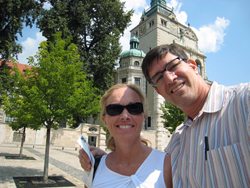 evaluations
by top spine
surgeons all
over the US and all over the world. The consensus seemed to be that with
a
fresh disc protrusion, the chance of symptoms resolving on their own
was substantial. She should try some epidural
steroid injections and wait to see if it would resolve on its
own. She had
one injection
in mid-June with very little (or no) benefit. evaluations
by top spine
surgeons all
over the US and all over the world. The consensus seemed to be that with
a
fresh disc protrusion, the chance of symptoms resolving on their own
was substantial. She should try some epidural
steroid injections and wait to see if it would resolve on its
own. She had
one injection
in mid-June with very little (or no) benefit.
Following
the injection, she
was still having constant low back pain, leg pain, numbness, and strength
loss. As the weeks wore on,
her symptoms
grew worse. By the time
we got to
be
two
months
post-injury, most of the doctors were saying that at this stage,
if it's going in the wrong direction, it's unlikely to have a good
resolution
without surgery. We evaluated many different surgical options. While
minimally
invasive spine surgery (MISS) is an attractive solution for many
discectomies, Diane's disc protrusion was so large and the sequester
had traveled
so far, that only Dr. Hoogland at the AlphaKlinik felt Diane was a
good candidate for MISS. Diane works at an excellent hospital
and had scheduled an open, microdiscectomy with a very good local
surgeon. Less
than a week before the surgery, our research again brought us to
MISS options and we decided that she'd come to Germany with me for
an evaluation
by doctors Thomas Hoogland (world leading endoscopic specialist)
and Herbert Baumbach (the most thorough neurologist I've ever met.) On
Saturday, July 28th, we left Los Angeles, arriving in Munich on Sunday.
More in Diane's words below.
THE
DECISION (Diane's
words)
Getting to the decision
to have surgery was a difficult process. After months of back pain,
leg pain, an MRI that showed a
very large herniation
at L5-S1, and not much relief from and epidural injection, I was ready
to do something. I wasn't in severe pain, but my activity level was
severely limited. This was not how I wanted to live. Mark
and I met with a
local spine surgeon and I was very impressed with him. Since he performs
surgery at the hospital I work in, I had already spoken to many nurses
and other OR staff. He's good. I was very comfortable with his approach
and I decided to go ahead and schedule surgery with him.
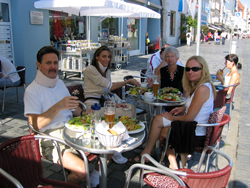 I still remember that day in
the doctor's office. Mark had a terrible look on his face when I told
the doctor that I wanted to schedule surgery.
When we left, Mark said, "I can't believe that you just scheduled surgery."
I asked him why he didn't say anything during the appointment. He said,
"I want you to make your own decision. I don't think your making a
mistake, but this would not be my choice." I still remember that day in
the doctor's office. Mark had a terrible look on his face when I told
the doctor that I wanted to schedule surgery.
When we left, Mark said, "I can't believe that you just scheduled surgery."
I asked him why he didn't say anything during the appointment. He said,
"I want you to make your own decision. I don't think your making a
mistake, but this would not be my choice."
Mark
had asked my surgeon many questions about details of the surgery, and
continued to talk to
other surgeons about specific techniques - pros and cons; consider: Do they evacuate
the disc
space or just go after the protrusion? How aggressively will they chase
the sequester - how far can they reach from one level? After more discussion
about my options, we decided to go for a second opinion with a surgeon
that Mark and I really trust. (John Regan).
He confirmed
that his recommendation was for a microdiscectomy
and had nothing but good things to say about my doctor. I was comfortable
with my decision. Mark was getting used to my decision, or so I thought.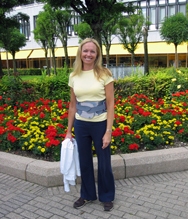
July
13, 2007 - Friday the thirteenth. (This section was written before we
left for Munich.) What a morning. I woke up and the sun was shining bright.
A perfect
beach day! I was hoping take Taffy
to the dog beach today. It has been quite a few days since she's been out,
but I'm having lots of leg pain. I felt so good yesterday. I went to
the family room where Mark was on his computer. I could tell that he
was
upset. He
hasn't been talking to me much lately - he says he's busy with work.
Yes, he's busy, but it is much more. He came to me and said, "I can't
believe that you are dismissing options before you fully understand them.
I believe
that this surgery will be successful, no matter which option you choose.
All of the discectomy options will remove the protrusion and decompress
the nerve. However, the disc is severely compromised and you may need further
surgery. What you do now may have serious implications, years later."
We
talked more and he voiced concerns that my surgery was next week and
you never know the
outcome. I was pretty much thinking of discectomy as a simple procedure,
forgetting that it was where Mark started years ago, 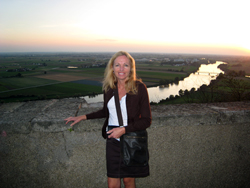 on
his way to "spinal hell". I
hadn't ever thought of myself as a chronic pain patient. As
far as I was concerned,
this was going to be my only surgery. As
we talked more, I decided that I should go see Dr. Hoogland and find
out more about his
procedure. A few minutes later, Mark was on the phone with Dr. Zeegers
to ask
if Dr. Hoogland would be in town the week before Mark's next trip to Germany.
Dr. Zeegers was so gracious with his time and well-wishes. (He had
personally called me a few weeks ago to explain that if my pain was bad,
there was no need to suffer. "Come to the AlphaKlnik
and they can fix it." He told me the story of his own back experience
- severe pain on the weekend. Endoscopic procedure
on Monday and at 2pm he rode his bike back to the hotel.) We wish it could
be that easy for all of us! on
his way to "spinal hell". I
hadn't ever thought of myself as a chronic pain patient. As
far as I was concerned,
this was going to be my only surgery. As
we talked more, I decided that I should go see Dr. Hoogland and find
out more about his
procedure. A few minutes later, Mark was on the phone with Dr. Zeegers
to ask
if Dr. Hoogland would be in town the week before Mark's next trip to Germany.
Dr. Zeegers was so gracious with his time and well-wishes. (He had
personally called me a few weeks ago to explain that if my pain was bad,
there was no need to suffer. "Come to the AlphaKlnik
and they can fix it." He told me the story of his own back experience
- severe pain on the weekend. Endoscopic procedure
on Monday and at 2pm he rode his bike back to the hotel.) We wish it could
be that easy for all of us!
I don't know why I changed my mind. I don't
feel like I was pressured, I just came to look at things differently.
I felt bad about canceling
surgery. I had mixed feelings: relieved that I wasn't having
surgery a few days later, but sorry that it wouldn't be behind me.
Pre-Op
day, July 30, 2007 (Diane)
The
day at the AlphaKlinik was a long and hectic one. I
was very comfortable because Mark was there looking out for
me. Also,
I'd been through it before with Mark, five years before, when our roles
were reversed. I
was great having someone like him to help me, but I tried to keep focused
and had my own
questions to ask. The
meeting with Dr. Hoogland went well and he answered all my concerns. A
new MRI was performed and it showed that the sequester had shrunk substantially. I
asked, "but why are my symptoms getting worse?" Dr.
Hoogland said that it's because the portion that's left is much harder
and pressing
on my spinal cord.
We
scheduled an endoscopic discectomy for the next day. I met with
Dr. Gregor Blome who performed a complete physical. (I've never had
a doctor draw his own labs before!) The AlphaKlinik is VERY thorough.
Dr. Blome also performed an ultrasound, essentially doing a full body scan
and
checking every organ. I also met with the anesthesiologist. The
endoscopic procedure is done under local anesthesia. I
felt better having a local because as a nurse, I know the
risks of general anesthesia.
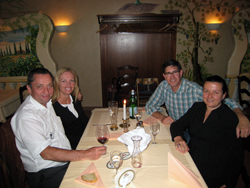 That
evening, we met with Dr. Baumbach for a complete neurological exam. He
was very personable and thorough. While some of Dr.
Baumbach's findings were a surprise, knowing my neurological status BEFORE
the surgery,
seems to be very important. That
evening, we met with Dr. Baumbach for a complete neurological exam. He
was very personable and thorough. While some of Dr.
Baumbach's findings were a surprise, knowing my neurological status BEFORE
the surgery,
seems to be very important.
Surgery,
July 31, 2007 (Diane)
I
was up early to have some tea and eat a few bites. Since
the surgery was to be done under local anesthetic, I was able to eat
and drink until 07:30. Of course I was nervous, but I felt like
I had made the best decision and was ready to proceed. We walked
over to the AlphaKlinik.
I left
Mark and was taken into the pre-op area. He went to get dressed
in scrubs to be in the OR. When he first asked if I wanted him on
the OR, I didn't think it was a good idea because he would be too emotionally
involved; but now it was very reassuring that he'd be there. They
gave me some medication IV in pre-op to relax me and I dozed off to sleep
peacefully. I remember being asked to turn on my side and
that's it. I woke
up several hours later in the recovery room and asked the nurse if the
surgery was
over. The nurse discontinued my IV, and then helped me put on the brace
and get up to a lounge chair where I had tea and cookies. 30 minutes
later and I was with Mark and on our way back to the hotel. That afternoon
and evening, I slept for hours. My pain was surgical pain, not
leg pain; and it was easily controlled with Tylenol and Codeine. Moving
and turning were done slowly. In the evening, I was starved and
ordered spaghetti from room service. I was greatly encouraged because
it seemed that my leg symptoms had been addressed and I was only dealing
with surgical pain.
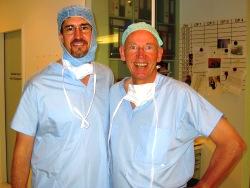 Mark
here: It was interesting going through the surgery day
with Diane. After they came
and took her to the pre-op area, I had some time to kill as the OR
staff said that they would call
me when she was going into the OR. It was clear that my role
was 'the husband'... and this was to be much different than my patient
advocate role that they are, and I am so used to. When I put
scrubs
on and went back into the operating theatre, Diane was already 'out'. She
was in such a light sleep that the slightest provocation would wake
her. Each time she'd wake, she'd look at me get such
a wonderful
smile. It was great to feel that I was offering such comfort to
her. (I
just wish that she remembered
it!) It was amazing how she was able to discuss and answer
questions, then when we stopped talking to her, she just went back
to sleep. No pain, no distress at all. Mark
here: It was interesting going through the surgery day
with Diane. After they came
and took her to the pre-op area, I had some time to kill as the OR
staff said that they would call
me when she was going into the OR. It was clear that my role
was 'the husband'... and this was to be much different than my patient
advocate role that they are, and I am so used to. When I put
scrubs
on and went back into the operating theatre, Diane was already 'out'. She
was in such a light sleep that the slightest provocation would wake
her. Each time she'd wake, she'd look at me get such
a wonderful
smile. It was great to feel that I was offering such comfort to
her. (I
just wish that she remembered
it!) It was amazing how she was able to discuss and answer
questions, then when we stopped talking to her, she just went back
to sleep. No pain, no distress at all.
When
the operation got underway, I was shocked by how anxious I
was. I've been in
the OR for
well over 150 surgeries now and have seen so much. It
was clear
that this was very
different
and I was
quite nervous at every step. Dr.
Hoogland is amazing. I already knew that because I've
been in the
OR with
him on several other occasions. Even so,
it is so impressive to see the accuracy and efficiency of a master
at work. His confidence is inspiring and his
intuition is spot on. While I still was anxious about the outcome
because under the best of circumstances, spine surgery is still something
of a
crap-shoot, I was certain that Diane had made a good choice and that
this was our best option. |
THE
RECOVERY (Diane's words)
In the first few days following the surgery, I felt that
my leg pain was gone, but my back pain had increased. I was controlled
with low levels of medication. (I took almost no pain meds before surgery,
so Codeine was very effective for me.) It was hard not to wonder if I had
done the right thing, as even a couple days after surgery; my low back
pain was still so much more than before. For the two days following the
surgery we stayed close to the hotel. Many of our meals were out at Arabella
Square and I took several short walks each day.
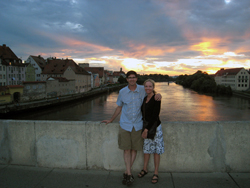 On the third day, we took a taxi into Munich and ate lunch
in the beer garden. We also went to my favorite bookstore. Mark posted
a more detailed progress report here on iSpine. Day four brought a trip to a Museum and on day five we walked
for miles in the English Garden. On the third day, we took a taxi into Munich and ate lunch
in the beer garden. We also went to my favorite bookstore. Mark posted
a more detailed progress report here on iSpine. Day four brought a trip to a Museum and on day five we walked
for miles in the English Garden.
Mark was very busy the next couple of weeks with business.
I increased my walks every day and weaned myself off the back brace and
the pain meds. I still needed the Celebrex. I was encouraged that at less
than 2 weeks post-op, I was able to walk for an hour. Leg symptoms came
and went at very low levels, but whenever I walked, my legs felt better.
My low back pain seemed to get better each day. I was walking faster, taking
longer steps and was able to move easier.
At just over two weeks post-op, Mark's business ended.
I was doing so well that we decided to extend our trip. We spent a couple
of nights at a wonderful hotel, enjoying Regensberg. Then we headed to
Prague for three days before returning home. Prague was wonderful! We were
able to walk the old town and eat at outdoor cafes at an incredible town
square.
We finally returned home on August 16 after being gone
for 25 days. It was great to be home. I was tired of staying in hotel
rooms and a little bit bored by the second week. Although, after being
home, I realized that it was good to limit my activities. Laundry and housework
do aggravate may back more than walking . .
September
9, 2007 - 6 weeks post-op (Diane)
I'm very happy with where
I am now. I'm taking Taffy to the dog beach almost every day and walking
almost 2 miles on the sand in addition to the long walk from the car. My
daily activities have increased. I spend less and less time sitting down
for rest periods. I still make my trips to
the market short and don't pick up heavy items. I still take Celebrex
and can tell if I miss a dose, because
I get some mild hip and low back pain. (Actually the hip pain is
much improved and almost gone.)
During
the last two weeks I've made a lot of progress. I'm happy with where
I am now.
I still feel some nerve symptoms on the top of my foot and outside of my
calf. Strangely, every morning, the middle toes on my right foot feel numb
when I wake, but this goes away soon after I get up. I continue
to improve, week by week.
If I didn't make any further progress, I could live with my symptoms.
I wake up feeling
good and look forward to my day. I'll keep you posted.
Diane
From
the pictures above, you can see that in less than 2 months, the appearance
of the disc
protrusion has
changed dramatically. Interestingly,
while Diane's symptoms were growing worse and worse, the fragment was getting
smaller and smaller. Our understanding is that the fresh protrusion
is all plump and soft, much like a grape. After a few months, it
is dehydrated and much smaller, but much firmer... like a grape shrinks
into
a raisin. It's easy to imagine how the smaller fragment can cause
more problems if it is much harder. We found it amazing that Dr.
Hoogland wanted to do another MRI, since the last one was less than 2 months
old. Part
of the decision is the poor 'gantry angle' on the previous MRI which has
the MRI aligned well for L4-5, but provides only a very oblique viewing
angle for L5-S1. With
a difficult endoscopic procedure, Dr. Hoogland felt that a more reliable
'map'
would
be useful. Fortunately, the MRI showed that what we thought would
be a very difficult procedure was then, quite ordinary. We were VERY
thankful that there was no time or effort spent looking for the large fragment
that
was no longer there. We wonder how much unnecessary collateral
damage was saved by not having to go on a snipe hunt. |

